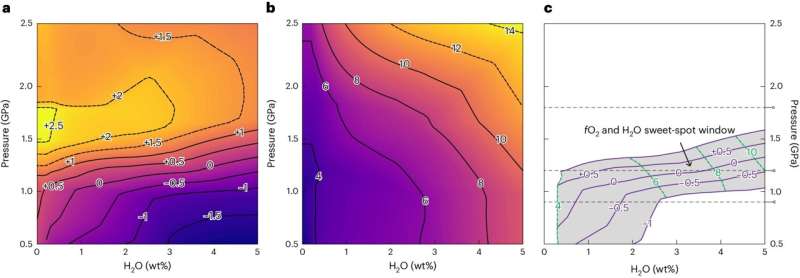This article has been reviewed according to Science X's editorial process and policies. Editors have highlighted the following attributes while ensuring the content's credibility:
fact-checked
peer-reviewed publication
trusted source
proofread
New model refutes leading theory on how Earth's continents formed

The formation of Earth's continents billions of years ago set the stage for life to thrive. But scientists disagree over how those land masses formed and if it was through geological processes we still see today.
A recent paper from the University of Illinois Chicago's David Hernández Uribe in Nature Geoscience adds new information to that debate, poking holes in the leading theory of continent formation. Hernández Uribe used computer models to study the formation of magmas, which is thought to hold clues to the origin of continents.
Magma is the molten substance that, when it cools, forms rocks and minerals. Hernández Uribe looked for magmas that match the compositional signature of rare mineral deposits called zircons that date back to the Archean period of 2.5 to 4 billion years ago, when scientists believed that continents first formed.
Last year, scientists from China and Australia published a paper arguing that Archean zircons could only be formed by subduction—when two tectonic plates collide underwater, pushing land mass to the surface. That process still happens today, causing earthquakes and volcanic eruptions and reshaping the coasts of continents.
But Hernández Uribe, assistant professor of earth and environmental sciences, found that subduction was not necessary to create Archean zircons. Instead, he found that the minerals could form through high pressure and temperatures associated with the melting of the Earth's thick primordial crust.
"Using my calculations and models, you can get the same signatures for zircons and even provide a better match through the partial melting of the bottom of the crust," Hernández Uribe said. "So based on these results, we still do not have enough evidence to say which process formed the continents."
The results also raise uncertainty about when plate tectonics started on Earth. If Earth's first continents formed by subduction, that meant that continents started moving between 3.6 to 4 billion years ago—as little as 500 million years into the planet's existence. But the alternative theory of melting crust forming the first continents means that subduction and tectonics could have started much later.
"Our planet is the only planet in the solar system that has active plate tectonics as we know it," Hernández Uribe said. "And this relates to the origin of life, because how the first continents moved controlled the weather, it controlled the chemistry of the oceans, and all that is related to life."
More information: David Hernández-Uribe, Generation of Archaean oxidizing and wet magmas from mafic crustal overthickening, Nature Geoscience (2024). DOI: 10.1038/s41561-024-01489-z
Journal information: Nature Geoscience
Provided by University of Illinois at Chicago





















